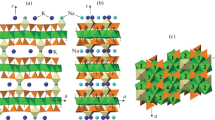Abstract
In this work, a crystal chemical analysis of the known experimentally deciphered crystal structures of tetrahedrite group minerals was carried out in order to reveal the relationships between the occupancies of anion crystallographic sites in the structures, their effective sizes and unit cell parameters. To achieve this aim, we analyzed the effective sizes of the 24g and 2a anion sites in 68 deciphered crystal structures of tetrahedrite group minerals according to the published data. The analysis was carried out using the TOPOSPro software package by partitioning the space into Voronoi–Dirichlet polyhedra (VDP). It has been shown theoretically for the first time that the content of a large sulfur ion and its deficiency affect the unit cell parameter. A linear correlation between the VDP volume of the anionic site of S2– (24g) and the unit cell parameter in minerals of the tetrahedrite group was established, which shows that the anionic substructure dictates the structural motif in this class of compounds. It was found that the change in the VDP volumes of sulfur anions is associated with different occupancies of anionic sites. It is found that the formula (unit cell) of the compound contains fewer than 13 sulfur ions in almost all deciphered crystal structures of tetrahedrite group minerals. It was concluded that the calculated VDP volume of the 24g anionic position less than 22 Å3 indicates a significant deficit in the anionic substructure. It was shown that, using information about the VDP volumes of all anionic and cationic sites in the structure, it is possible to predict the unit cell parameters of minerals of the tetrahedrite group with an accuracy of 0.01 Å.



Similar content being viewed by others
Notes
According to the data of Mozgovaya and Tsepin [2], the inflection in the dependence of parameter a0 on the Ag content is when the Ag content = 3.7 Ag atoms in the formula.
a0 (Å) = 10.319 – 0.059KAs + 0.075(ΣMe:S) [6], where Ki are formula coefficients of the respective elements, the ΣMe:S ratio is the nonstoichiometry measure. a0 (Å) = 10.319 + 0.017KFe + 0.027(ΣMe:S) [4]; a0 (Å) = 10.319 + 0.031KFe + 0.028KZn + 0.096KHg + 0.007(ΣMe:S) – 0.040KAs + “Ag” [2], where “Ag” = KAg/(21.9-1.01KAg), when the Ag content is <3.7 atoms in the formula and “Ag” = 1/(1.66KAg – 1.28) when the Ag concentration is >3.7 atoms in the formula.
REFERENCES
C. Biagioni, L. L. George, N. J. Cook, E. Makovicky, Y. Moëlo, M. Pasero, J. Sejkora, C. J. Stanley, M. D. Welch, and F. Bosi, Am. Mineral. 105 (1), 109–122 (2020). https://doi.org/10.2138/am-2020-7128
N. N. Mozgova and A. I. Tsepin, Fahlores: Features of Chemical Composition and Properties (Nauka, Moscow, 1983) [in Russian].
N. G. Lyubimtseva, N. S. Bortnikov, S. E. Borisovsky, V. Yu. Prokofiev, and O. V. Vikent’eva, Geol. Ore Deposits 60 (2), 93–120 (2018). https://doi.org/10.1134/S1075701518020034
K. Tatsuka and N. Morimoto, Am. Mineral. 62 (11-12), 1101–1109 (1977).
N. S. Bortnikov and I. Ya. Nekrasov, Dokl. Akad. Nauk SSSR 297 (2), 449–451 (1987).
F. D. Luce, C. L. Tuttle, and B. J. Skinner, Econ. Geol. 72 (2), 271–289 (1977). https://doi.org/10.2113/gsecongeo.72.2.271
N. V. Belov and E. A. Pobedimskaya, Mineral. Sb. L’vov. Gos. Univ. im. I. Franko, Iss. 1 (27), 3–9 (1973).
M. D. Welch, C. J. Stanley, J. Spratt, and S. J. Mills, Eur. J. Mineral. 30 (6), 1163–1172 (2018). https://doi.org/10.1127/ejm/2018/0030-2773
C. Biagioni, J. Sejkora, Y. Moëlo, E. Makovicky, M. Pasero, and Z. Dolniček, Mineral. Mag. 84, 971−975 (2020). https://doi.org/10.1180/mgm.2020.93
K. Qu, X. Sima, X. Gu, W. Sun, G. Fan, Z. Hou, P. Ni, D. Wang, Z. Yang, and Y. Wang, Mineral. Mag. 85, 278−281 (2021). https://doi.org/10.1180/mgm.2021.5
Z. Shu, C. Shen, A. Lu, and X. Gu, Crystals 12 (4), 467 (2022). https://doi.org/10.3390/cryst12040467
R. O. Sack, N. G. Lyubimtseva, N. S. Bortnikov, E. Y. Anikina, and S. E. Borisovsky, Contrib. Mineral. Petrol. 177 (8), 82 (2022). https://doi.org/10.1007/s00410-022-01942-5
I. V. Rozhdestvenskaya, N. V. Zayakina, and V. P. Samusikov, Mineral. Zh. 15, 9 (1993).
V. A. Blatov, A. P. Shevchenko, and D. M. Proserpio, Cryst. Growth Des. Am. Chem. Soc. 14 (7), 3576–3586 (2014). https://doi.org/10.1021/cg500498k
Funding
This work was carried out under project no. 121041500220-0 “Structural and Chemical Inhomogeneities and Paragenetic Mineral Associations as a Reflection of the Petro- and Ore Genesis” of the Institute of Geology of Ore Deposits, Petrography, Mineralogy, and Geochemistry, Russian Academy of Sciences.
Author information
Authors and Affiliations
Corresponding author
Ethics declarations
The author declares that he has no conflicts of interest.
Additional information
Translated by L. Mukhortova
Rights and permissions
About this article
Cite this article
Lyubimtseva, N.G., Marchenko, E.I., Eremin, N.N. et al. To a Question of Sulfur Sites in Crystal Structures of Tetrahedrite Group Minerals: Relationships between Occupancy, Effective Ion Sizes, and Unit Cell Parameters. Dokl. Earth Sc. 512, 824–828 (2023). https://doi.org/10.1134/S1028334X23601189
Received:
Revised:
Accepted:
Published:
Issue Date:
DOI: https://doi.org/10.1134/S1028334X23601189



